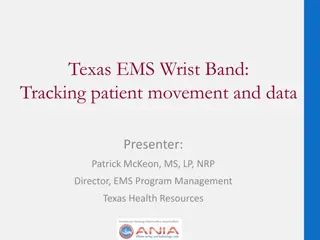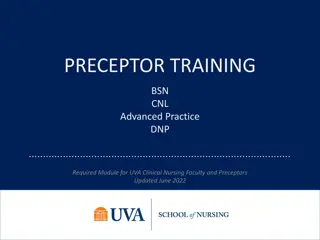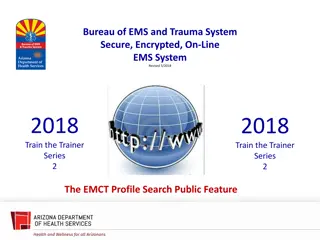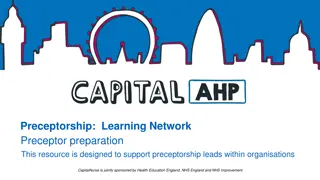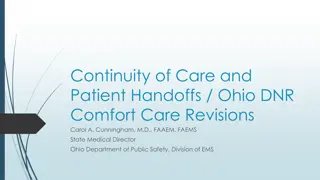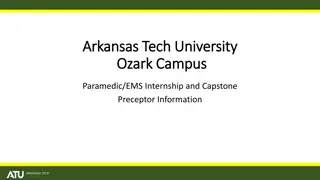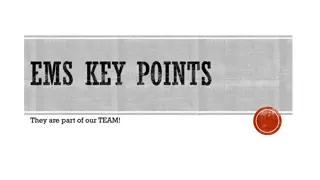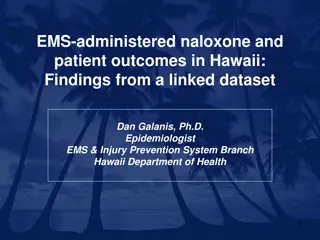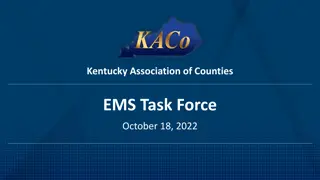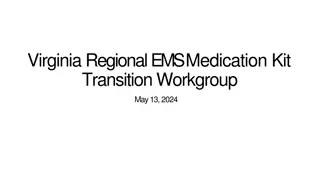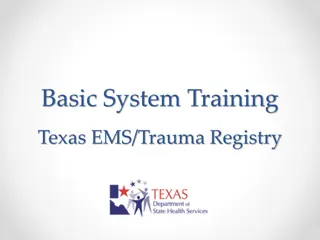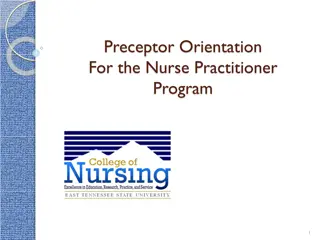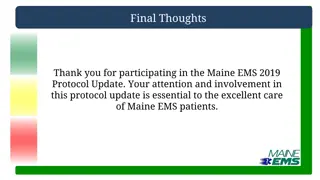Preceptor Training Guide for EMS Department at Southern West Virginia Community and Technical College
This training guide is designed to assist preceptors in their role of mentoring paramedic students from Southern West Virginia Community and Technical College. It outlines the responsibilities of a preceptor, emphasizes the importance of establishing a supportive relationship with students, and highlights key aspects of guiding and evaluating student progress. The guide also emphasizes the significance of demonstrating professionalism and fostering a positive learning environment for students to thrive in their field placements.
Download Presentation

Please find below an Image/Link to download the presentation.
The content on the website is provided AS IS for your information and personal use only. It may not be sold, licensed, or shared on other websites without obtaining consent from the author.If you encounter any issues during the download, it is possible that the publisher has removed the file from their server.
You are allowed to download the files provided on this website for personal or commercial use, subject to the condition that they are used lawfully. All files are the property of their respective owners.
The content on the website is provided AS IS for your information and personal use only. It may not be sold, licensed, or shared on other websites without obtaining consent from the author.
E N D
Presentation Transcript
Preceptor Training Guide Southern West Virginia Community and Technical College Emergency Medical Services Department
Welcome Thank you for serving as a preceptor for our program and sharing your clinical knowledge with the paramedic students from Southern. Your time and energy are truly appreciated and we recognize that you make a significant impact in preparing future field personnel
We have prepared this power point slide show as an insert to the Paramedic Student Program and Clinical Handbook and on the Southern website under Programs of Study for you as a reference guide for your role in contacting and interacting with the college and our students
Roles and Responsibilities of the Preceptor
You are the Preceptor You should demonstrate genuine interest in the student. Be willing to commit time and expertise to guide the student be available for any questions or concerns. Apply new concepts to the student s prior learning when possible. Use good communication skills listen, share, and respect the student s input Focus on students strengths and help the student build up weaknesses.
You are the Guide Develop a trusting, open relationship. Help promote problem solving. Use reflection to help students learn from experiences. Use positive strategies; help students feel as if they belong in EMS. Correct mistakes in a timely, supportive fashion, zeroing in on remediation and how to avoid mistakes in the future.
Simple and Basic Remember what may seem basic or easy for you, the preceptor, may not be basic or simple to the student
Role of the Paramedic Student Demonstrate professional behavior. Display the knowledge and skills that you acquired during the didactic (classroom) portion of your paramedic education and training. Progress from the role of observer to the role of paramedic participant. During the field portion of your internship, you will be expected to perform at the level of an entry-level paramedic.
Role of the Paramedic Student Observe, and then perform skills and procedures at the direction of your Preceptor. All skills are to be preformed under the direct supervision of a Preceptor. Remember numerous procedures can be applied to any situation, including materials. Follow policies and procedures set forth by the facility.
Domains of Learning Learning Objectives set for students dividing educational objectives into three "domains. Cognitive knowing/head Affective feeling/heart Psychomotor - doing/hands
Domains of Learning Affective or Feeling/Heart Reaction emotionally. Can they feel other living things' pain or joy. Are they growing in the ability to care for others, how is the attitude changing.
Domains of Learning Psychomotor or Doing/Hands Ability to development in behavior. Ability to perform skills. Getting the knowledge from the head to hands.
Domains of Learning Cognitive Domain or Knowing/Head Student knowledge of the topic. Student comprehension of the subject. Critical Thinking when It s not textbook.
Learning Styles Visual:The occipital lobes at the back of the brain manage the visual sense. Both the occipital and parietal lobes manage spatial orientation. Aural:The temporal lobes handle aural content. The right temporal lobe is especially important for music. Verbal: The temporal and frontal lobes, especially two specialized areas in the left hemisphere of these two lobes. Physical:The cerebellum and the motor cortex (at the back of the frontal lobe) handle much of our physical movement.
Learning Styles Logical:The parietal lobes, especially the left side, drive our logical thinking. Social:The frontal and temporal lobes handle much of our social activities. The limbic system also influences both the social and solitary styles. The limbic system has a lot to do with emotions, moods and aggression. Solitary:The frontal and parietal lobes, and the limbic system, are also active with this style.
Learning Environment Learning environment will have an effect on student learning in many ways such as: The Physical location or Service Preceptor Attitude Setting of which the material is presented Culture of the class, work area, etc
Learning Environment Is your clinical area learning friendly? Does the student feel comfortable with the preceptor? Can the student ask questions without fear of being put down or making to feel stupid?
Learning Environment In order to get the most out of the rotation the student must feel comfortable in all areas.
Giving Feedback Establish a respectful and cheerful learning environment. Communicate and discuss goals and objectives for feedback. Base feedback on direct observation of student performance. Make feedback timely and a regular occurrence. Reinforce good behavior.
Giving Feedback Use specific language to discuss student performance. Confirm the learner s understanding Discuss action plan for the next rotation. Reflect on shifts skill performance. Give feedback in a positive manner.
Southern WV Community and Technical College Paramedic Program Hospital Clinical Report Shift Entry (Fill in blanks and circle all that apply) FISDAP Data Entered Date ______________ Time _________ All Clinical Assessments must be entered into FISDAP within 72 hours of clinical rotation to obtain credit. Once entered into FISDAP this form is to be turned into the clinical instructor the next class/lab session. DATE SITE DEPARTMENT (Circle) Logan Regional Medical Center Beckley ARH ETT ATTEMPT # 1 2 3 4 Tube Size Successful Y/N Patient Age Time BVM Ventilated Y/N Observers Initials (Mandatory) Total Attempts for this clinical _________ Total Successful ________ IV ATTEMPT # 1 2 3 4 Gauge Successful Y/N Patient Age Time Location of IV (RH,AC etc.) Observers Initials (Mandatory) Total Attempts for this clinical _________ Total Successful ________ Page 1 TIME IN OUTSTUDENT NAME ER | O.R. | O.B. | PEDS | CCU | ICU | Other ________ ER | O.R. | O.B. | PEDS | CCU | ICU | Other ________ ER | O.R. | O.B. | PEDS | CCU | ICU | Other ________ 5 6 7 8 9 NOTES 5 6 7 8 9 10 11 12 13 14 15 16 Medication Name 12. IM SQ PO IV ETT Medication Name 1. IM SQ PO IV ETT 13. . 2. 14. 3. 15. 4. 16. 5. 17. 6. 18. 7. 19. 8. 20. 9. 21. 10. 22. 11.
Evaluation On the back of the form you will find the following box for evaluation of the student If you need to confer with college officials you may contact Kathy Deskins, EMS Coordinator at the office 304.896.7316 or by cell phone 304.687.2994 If coordinator unavailable you may contact Russell Saunders, Dean, School of Career & Technical Studies. 304.896.7365
TO BE FILLED OUT BY PRECEPTOR/RN Performance Rating This area is to be completed by Preceptor before leaving clinical site 1 Needs more training Rating AREA OF PERFORMANCE Professionalism/Attitude: The student s behavior demonstrated integrity_, empathy_, self-motivation_, self- confidence_, teamwork_, diplomacy_, respect_, patient advocacy_, careful delivery of service_, appropriate time management_, appropriate appearance_ and personal hygiene_. Preceptor comment: Clinical Objectives: Demonstrates good attendance_; reported to work on time_ and in full uniform_; seeks-out learning experiences at every opportunity_; practices required skills_; develops interpersonal skills_; and advances the good standing of Southern's Paramedic Program_. Preceptor comment: Psychomotor Skills: The student accomplishes psychomotor skills and patient assessments completely and proficiently. Preceptor comment: Unsatisfactory Requires Assistance Tentative Needs Guidance 3Competent Minimal Prompting Entry Level Paramedic Good No prompting Performed as an Entry-Level Paramedic 2 4 5
Student Name: Date: TIME IN: TIME OUT: Service Name: Unit: Field Preceptor Name: Date: Please check one: Team Leader Yes No DISPOSITION/CALL OUTCOME DISPATCH RACE/SEX AFRICAN AMERICAN AMERICAN INDIAN ASIAN CAUCASIAN HISPANIC OTHER M F AGE NON-EMERGENT NONEMBERGENT TRANSFER EMERGENT ARREST/CRITICAL TRANSPORT ROUTINE TRANSPORT EMERGENCY REFUSAL TREATMENT TREATED RELEASED TRANSFER TO ANOTHER UNIT TREATED - REFUSED TRANSPORT D.O.A REFUSAL CANCELLED STANDBY PATIENTCATEGORY AGE IN YEARS AGE IN MONTHS CHIEF COMPLAINT: PRIMARY AND SECONDARY FIELD IMPRESSION (What you think is wrong with the patient) Primary Secondary MEDICALPrimary Secondary TRAUMA Primary Secondary MEDICAL MECHANISM OF INJURY NONE STEERING WHEEL DEFORMED DASHBOARD DEFORMED WINDSHIELD SPIDERWEBBED EJECTION ENTRAPMENT PINNED IN VEHICLE DOA SAME VEHICLE ROLLOVER OTHER __________________ AUTO-PEDESTRIAN MOTORCYLE PENETRATING INJURY ___Gunshot wound ___Knife BLUNT T INJURY FALL/JUMP _____________ DRIVER MVA PASSENGER MVA_______ AIRBAG ________________ SEATBELT ______________ REVISED TRAUMA SCORE GCS 13-15 Points 9-12 6-8 4-5 0-3 Systolic >89 mmHg BP 76-89 mmHg 50-75 mmHg 1-49 mmHg NONE Respira- 10-29/min tory >29/min Rate 6-9/min 1-5/min NONE ABDOMINAL/GI RESPIRATORY CARDIAC CVA/TIA DIABETIC DOA NOCPR OB BIRTH/DELIVERY GYN OB-LABOR PREGNANCY PROBLEMS OD POISON PSYCHIATRIC SEIZURE SEPSIS/INFECTION OTHER MEDICAL _______________ ABDOMEN CHEST EXTREMITIES MUSCULOSKELETAL HEAD/FACE NECK-BACK PELVIC MULTI-SYSTEMS EXTREMITIES OTHER NEURO _______________ MEDICAL HISTORY MEDICATION PAST HISTORY 4 3 2 1 0 4 3 2 1 0 4 3 2 1 0 ALLERGIES VITAL SIGNS TIME INITIAL GLASGOW COMA SCALE EYES OPEN BP PULSE RESP LOC AVPU BEST VERBAL BEST MOTOR ALERT VERBAL PAINFUL UNRESPONSIVE SPONTANEOUS 4 TO VOICE 3 TO PAIN-2 NONE 1 ORIENTED-5 CONFUSED-4 INAPPROPRIATE.-3 GARBLED-2 NONE-1 OBEYS COMMANDS-6 PAIN/LOCAL-5 PAIN/WITHDRAWAL-4 PAIN/FLEXION-3 PAIN/EXTENSION-2 NONE-1 Total Adult Score ALS PROCEDURES *Please designate whether observed or performed AIRWAY MEDICATIONS DRUG _______________ _______________ _______________ _______________ _______________ _______________ _______________ _______________ _______ O ALS IV/IO ACCESS DOSE _______ _______ _______ _______ _______ _______ _______ ROUTE ______ ______ ______ ______ ______ ______ ______ ______ P ATTEMPTSSUCCESSETSIZEOP ATTEMPTS SUCCESS SITE GUAGE OP GLUCOMETER CHECK ______ ASSESSMENT-BASED MANAGEMENT/PLAN/TREATMENT NARRATIVE
For Field Evaluation Preceptor Comprehensive Assessment and Treatment Evaluation GRADING SCALE 4 Proficient Field Competent 3 Acceptable Appropriate for Experience 2 Needs Improvement (See preceptor comments) 1 Dangerous to Practice SKILLS Interview: Completed Comprehensive interview. Demonstrates active listening Exam: Completed an appropriate head-to-toe and/or focused physical examination Skill: Interventions performed or suggested were complete, satisfactory and timely Leadership: Set priorities, self-directed, and adapted to evolving information and findings Preceptor Comments: __________________________________________________________________________ ____________________________________________________________________________________________ ____________________________________________________________________________________________ ____________________________________________________________________________________________ ____________________________________________________________________________________________ Preceptor Signature: Date PCR s are required in all phases of field internship. One PCR per patient will be completed. All Field Team Leader Assessments must be entered into FISDAP within 72 hours of clinical rotation to obtain credit. Once entered into FISDAP this form is to be turned into the clinical instructor the next class/lab session. Contact Kathy Deskins, Program Coordinator, 304/896-7316, Katherine.Deskins@southernwv.edu. Please call with any comments or concerns. DEFINITION Employable as a functioning Paramedic Functioning at level expected in the program Needs further practice and education to improve Hazard to the patient and others 4 3 2 1 4 3 2 1 4 3 2 1 4 3 2 1 Student Signature:
PSYCHOMOTOR SKILLS Competencies Required ADMINISTER MEDICATION 25 TIMES ENDOTRACHEAL INTUBATION 5TIMES* VENOUS ACCESS 25TIMES *SEE ATTACHED CoAEMSPAIRWAY MANAGEMENT RECOMMENDATION
AGES Competencies Required COMPREHENSIVE ASSESSMENT ON 30 PEDIATRIC PATIENTS AS FOLLOWS: NEWBORN 2 INFANT 2 TODDLER 2 PRESCHOOLER 2 SCHOOL AGE 2 ADOLESCENT 2 COMPREHENSIVE ASSESSMENT ON 50ADULT PATIENTS COMPREHENSIVE ASSESSMENT ON 30GERIATRIC PATIENTS (65 and older)
COMPLAINTS COMPREHENSIVE ASSESSMENT ON 10 OBSTETRIC PATIENTS COMPREHENSIVE ASSESSMENT ON 40 TRAUMA PATIENTS COMPREHENSIVE ASSESSMENT ON 20 PSYCHIATRIC PATIENTS COMPREHENSIVE ASSESSMENT ON 20 ALTERED MENTAL STATUS PATIENTS COMPREHENSIVE ASSESSMENT ON 20 ABDOMINAL PAIN COMPREHENSIVE ASSESSMENT ON 20 ADULT DYSPNEA COMPREHENSIVE ASSESSMENT ON 10 CHANGE IN RESPONSIVENESS COMPREHENSIVE ASSESSMENT ON 30 CHEST PAIN
COMPLAINTS Competencies Required COMPREHENSIVE ASSESSMENT, FORMULATE AND IMPLEMENT A TREATMENT PLAN FOR 30PATIENTS WITH CHEST PAIN COMPREHENSIVE ASSESSMENT, FORMULATE AND IMPLEMENT A TREATMENT PLAN FOR 20PATIENTS WITH DYSPNEA/RESPIRATORY DISTRESS COMPREHENSIVE ASSESSMENT, FORMULATE AND IMPLEMENT A TREATMENT PLAN FOR 8PEDIATRIC PATIENTS WITH DYSPNEA/RESPIRATORY DISTRESS COMPREHENSIVE ASSESSMENT, FORMULATE AND IMPLEMENT A TREATMENT PLAN FOR 10PATIENTS WITH SYNCOPE COMPREHENSIVE ASSESSMENT, FORMULATE AND IMPLEMENT A TREATMENT PLAN FOR 20PATIENTS WITH ABDOMINAL COMPLAINTS (EX. ABDOMINAL PAIN, NAUSEA/VOMITING, GI BLEEDING, ETC.) COMPREHENSIVE ASSESSMENT, FORMULATE AND IMPLEMENT A TREATMENT PLAN FOR 50 TRIAGE PATIENTS
TEAM LEADER SKILLS Competencies Required SERVE AS A TEAM LEADER IN A VARIETY OF PREHOSPITAL EMERGENCY SITUATIONS FOR 50RESPONSES TEAM LEADER SKILLS ARE ONLY BE COMPLETED DURING THE FIELD ROTATION
Thank you Once again we would like to thank you for taking part in the education of our future advanced life support providers.
Sources http://thesecondprinciple.com/instructional- design/threedomainsoflearning/ learning-styles-online.com http://edglossary.org/learning-environment/ http://sse.umontreal.ca/apprentissage/documentation/Ramani_KracKov_20 12_Tips_Feedback.pdf



